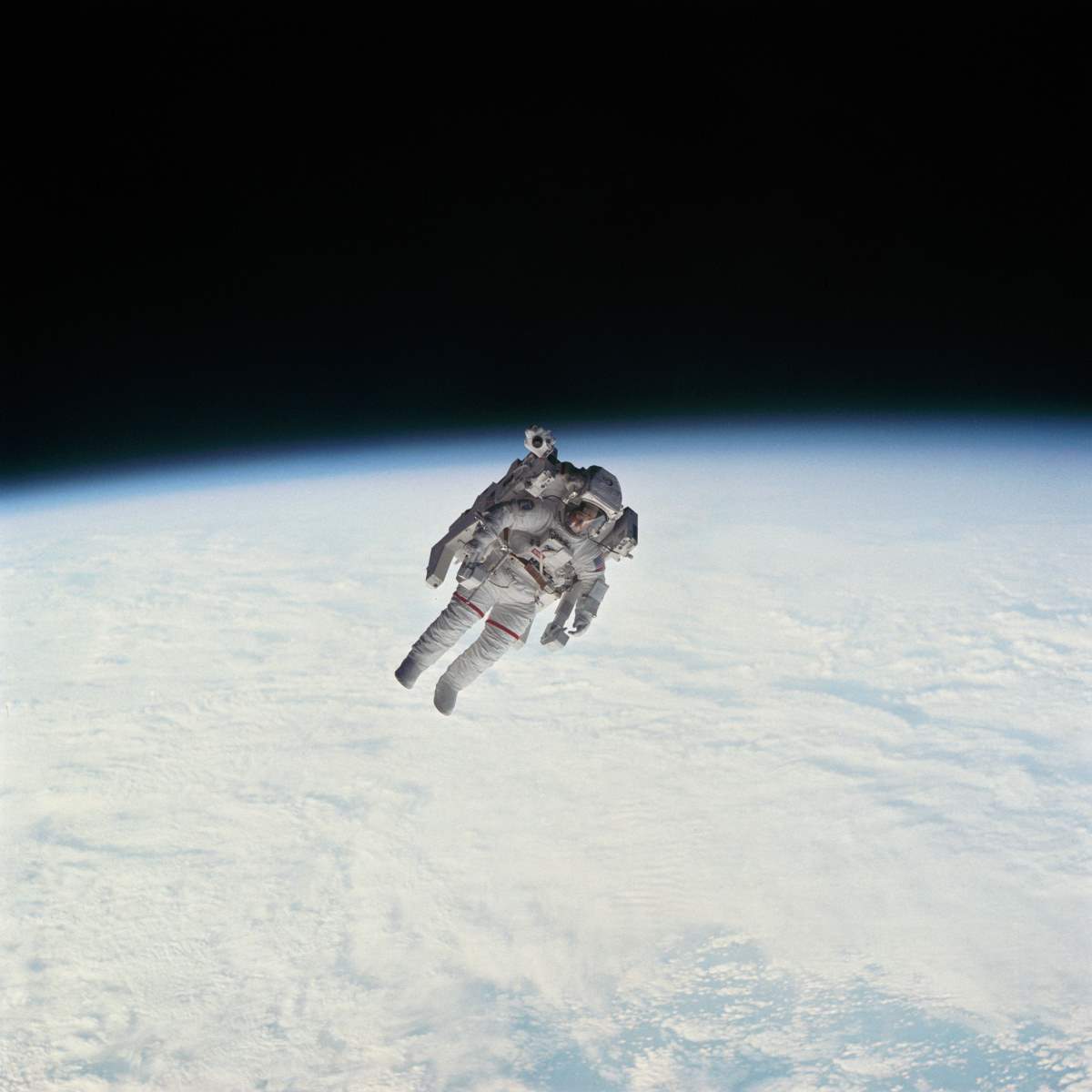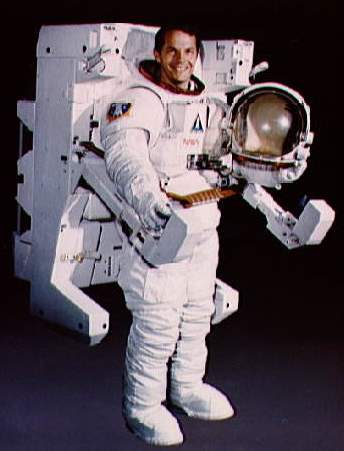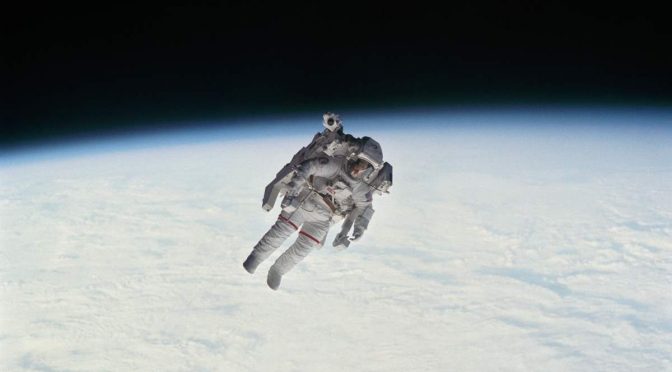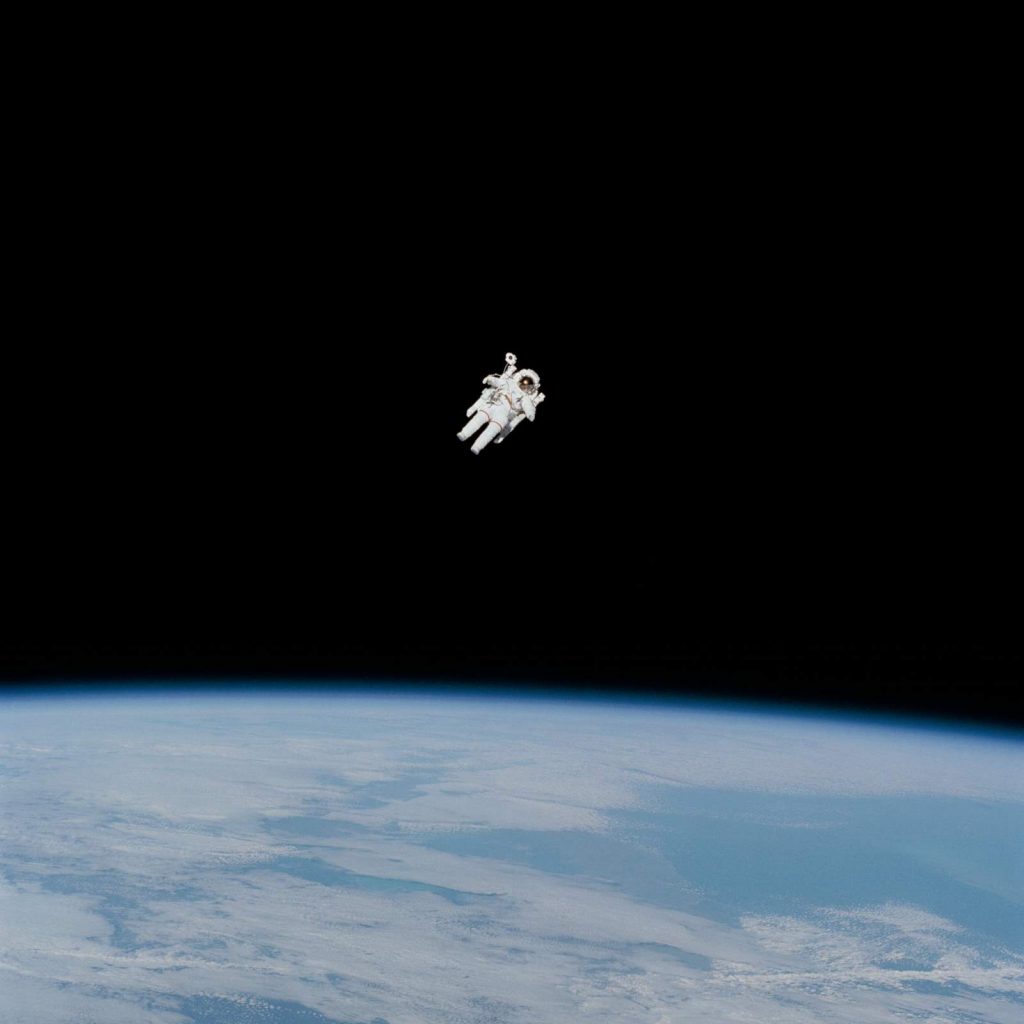A breathtakingly beautiful photo of a historical moment: NASA Astronaut Robert L. Stewart untethered above the Earth during the first Manned Maneuvering Unit (MMU) exercise. The photo was taken on February 7, 1984, during the EVA 1 (Extravehicular activity) of STS-41-B, the tenth NASA Space Shuttle mission, and the fourth flight of the Space Shuttle Challenger. The total duration of the spacewalk was 5 hours 55 minutes. Bruce McCandless II and Robert L. Stewart tested a nitrogen-propelled, hand-controlled backpack device called the Manned Maneuvering Unit (MMU). In this EVA, Bruce McCandless II broke the untethered spacewalking record with a distance of 98 meters (320 feet).

STS-41-B Mission Summary
Space Shuttle Challenger lifted off from Kennedy Space Center, Florida at 8 am EST on February 3, 1984. Two communications satellites were deployed about 8 hours after launch; one, Westar 6, was for America’s Western Union, and the other, Palapa B2, for Indonesia. However, the Payload Assist Modules (PAM) for both satellites malfunctioned, placing them into a lower-than-planned orbit. Both satellites were retrieved successfully in November 1984 during STS-51-A, which was conducted by the orbiter Discovery.
The STS-41-B crew included commander Vance D. Brand, making his second Shuttle flight; pilot Robert L. Gibson; and mission specialists Bruce McCandless II, Ronald E. McNair, and Robert L. Stewart.
On the fourth day of the mission, astronauts McCandless and Stewart performed the first untethered spacewalk, operating the Manned Maneuvering Unit (MMU) for the first time. McCandless ventured out 320 feet (98 meters) from the orbiter and broke the untethered spacewalking record which still stands, while Stewart tested the “work station” foot restraint at the end of the Remote Manipulator System. On the seventh day of the mission, both astronauts performed another EVA to practice capture procedures for the Solar Maximum Mission satellite retrieval and repair operation, which was planned for the next mission, STS-41-C.
STS-41-B also achieved the reflight of the West German-sponsored SPAS-1 pallet/satellite, which had originally flown on STS-7. This time, however, it remained in the payload bay due to an electrical problem in the RMS.
The mission also carried five GAS canisters, six live rats in the middeck area, a Cinema-360 camera, and a continuation of the Continuous Flow Electrophoresis System and Monodisperse Latex Reactor experiments. Included in one of the GAS canisters was the first experiment by a high school team to fly in space. The experiment, on seed germination and growth in zero gravity, was created and built by a team from Brighton High School in Utah through a partnership with Utah State University.
The 7-day, 23-hour, 15-minute, 55-second flight ended on February 11, 1984, with a successful landing at Kennedy Space Center’s Shuttle Landing Facility. This marked the first landing of a spacecraft at its launch site. Challenger completed 127 orbits and traveled 2.8 million miles.
Astronaut Ronald E. McNair would later die in the Challenger disaster on 28 January 1986.
Space Shuttle Challenger
Space Shuttle Challenger (Orbiter Vehicle Designation: OV-099) was the second orbiter of NASA’s space shuttle program to be put into service following Columbia. Its maiden flight, STS-6, started on April 4, 1983. It launched and landed nine times before breaking apart 73 seconds into its tenth mission, STS-51-L, on January 28, 1986, resulting in the death of all seven crew members.
Notes
- Robert Lee Stewart (born August 13, 1942) is a retired brigadier general of the United States Army and a former NASA astronaut. He became a NASA astronaut in August 1979. His technical duties in the Astronaut Office included: testing and evaluation of the entry flight control systems for STS-1 (the first Space Shuttle orbital mission), ascent abort procedures development, and payload coordination. He also served as support crewman for STS-4, and Ascent/Orbit CAPCOM for STS-5. He served as a mission specialist on STS-41-B in 1984 and STS-51-J in 1985, and logged a total of 289 hours in space, including approximately 12 hours of EVA operations.

Sources
- STS-41-B on Wikipedia
- Robert L. Stewart on Wikipedia
- Space Shuttle Challenger on Wikipedia
- Manned Maneuvering Unit on W
ikipedia
- Space Shuttle Endeavour’s Touchdown Meets Columbia’s Salute [An amazing photo from the past] - February 29, 2024
- Moon Landings: All-Time List [1966-2024] - February 23, 2024
- From Orbit to Ordinary: 10 Earthly Applications of Space Technology - January 23, 2024

